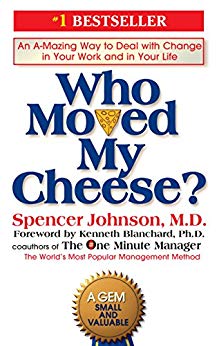

This article is an excerpt from the Shortform summary of "Who Moved My Cheese" by Spencer Johnson. Shortform has the world's best summaries of books you should be reading.
Like this article? Sign up for a free trial here .
No matter what environment we operate in — whether a town, city, family, relationship, workplace, or other setting — change is inevitable. Who Moved My Cheese by Spencer Johnson is a parable about a place that changed, and how its inhabitants reacted. Through the characters’ triumphs and travails, the story offers lessons and tips for how to deal with change in life by changing our attitudes and behavior.
We’ll cover the story of Who Moved My Cheese and discuss how you can apply its lessons every day to learn how to deal with change in life.
The Story: How to Deal With Change in Life
The parable unfolds in a maze, where four characters — two mice (Sniff and Scurry) and two tiny humans (Hem and Haw), search for cheese, which represents happiness. They get pretty good at this. The mice use their simple, rodent-specific talents of sniffing out cheese and scurrying around until they find it. Hem and Haw use their human thinking and analytical skills to also find cheese. They find a huge supply and all four enjoy its benefits for quite a while.
One day the maze dwellers confront a crisis: The cheese is gone. All four characters must adapt in one way or another to their changed circumstances.
The mice are the best equipped at the outset. We’ll see that they hold the secrets to how to deal with change in life:
- They’re not surprised at the change because they noticed it happening. They stayed observant and noticed that the cheese was getting old and the pile was shrinking.
- They’re ready to act because they’ve stayed alert and anticipated change.
- They act quickly to adapt – they immediately put on their running shoes, which they’ve kept at the ready, and set out to find new cheese.
- They’re persistent, eventually finding a new stockpile.
- Even with new cheese at hand, they monitor the situation and check around for new supplies because they know things will change again.
Because he rejects change, Hem is the character most people wouldn’t want to be, but we all probably share some of his characteristics some of the time.
- Hem has come to regard the cheese as his entitlement. He feels he deserves it.
- When the cheese disappears, he complains about the unfairness. He gets angry and seeks someone to blame.
- Hem denies reality, believing and insisting to Haw that the cheese will reappear.
- Hem holds onto the past. He thinks that digging in and doing what he’s done in the past will negate change. (He keeps exploring the neighboring area for cheese, instead of venturing out for new cheese)
- And despite a lack of success, and despite the fact that he is hurting himself, Hem refuses to act any differently.
Haw is the character who experiences the most change in the story. Initially, like Hem, he’s upset, overwhelmed and also in shock that the cheese has disappeared. At first, he follows Hem’s lead in sitting around complaining and waiting for the cheese to reappear. He whines about the injustice of it all. This is the response of many people dealing with life changes.
But eventually, Haw realizes that things aren’t going to improve unless he acts. This is a key moment in learning how to deal with change in life. Despite Hem’s attempts to discourage him, Haw strikes out on his own to find new cheese. He is afraid of failing, but he overcomes his fear by asking himself, “What would you do if you weren’t afraid?” He keeps going.
Taking control increases his confidence, and he starts to enjoy moving in a new direction. He finds some small pieces of new cheese, which he takes back to the starting point to share with Hem, but Hem isn’t interested in trying the new cheese or looking for more. He still just wants things to return to the way they used to be. Haw realizes he can’t change Hem — Hem will have to change himself, or not.
So Haw returns to his search for new cheese, and he finally comes upon the large new stockpile that the mice had found earlier. After celebrating success, he reflects on the experience and pledges to anticipate change and adapt quickly in the future. He has learned how to deal with change in life.
8 Lessons in Dealing With Life Changes
As old friends at a reunion compare their lives and confess to being unsettled by change, one classmate relates the cheese story. The friends talk about which characters they resembled when dealing with life changes. Some lessons on how to cope with change in life include:
- If you stubbornly resist change at work, you could end up being fired or let go. The same can happen if you fail to notice change because your mindset is anchored in the past.
- A family retail business that doesn’t change its ways, or change fast enough, to compete with mega-stores could find itself out of business. In a case like this, it might have been better to initiate change than to react to it later.
- A business that’s been successful in the past (for example, an encyclopedia-selling business) cannot rely on its business model working forever. (Cheese eventually runs out.)
- An important role of managers is to lead employees uncertain about or fearful of change, by painting a picture of success they can get excited about. (Picture the new cheese.)
- From a management standpoint, understanding which characters your employees emulate can help you to help them adapt, while benefiting the company as a whole.
- Sniffs can help a company innovate by sniffing out opportunity.
- Action-oriented Scurrys can get things done.
- Haws are hesitant but can adapt with encouragement.
- Hems may choose not to adapt even when given the evidence. They might then stop being good fits for your organization.
- Personal relationships can appear “old” like “old cheese,” but this may be the result of old, now unproductive behaviors. New attitudes and behaviors can transform a relationship into something better (new cheese).
- People are more afraid of and more resistant to change when it’s imposed on them from above, because they feel powerless. Peer pressure can also be a factor. Understanding that change is natural and has advantages can help lessen resistance.
- One suggested strategy is to ask your colleagues to read the book. People can then self-identify with the characters, and no one wants to be seen as a Hem!
- Even though you fear change because of what you think you’re losing, you can end up with something better.
- Example: A family has to move from the city to the mountains for work. The teenage son is crushed, since he has to give up his swim team. But unexpectedly he learns to ski, and enjoys that even more.)
These lessons in how to deal with change in life can be hard to learn, but they’re simple in concept. Dealing with life changes is something everyone experiences–learn how to cope with changes in life successfully.
———End of Preview———

Like what you just read? Read the rest of the world's best summary of "Who Moved My Cheese" at Shortform . Learn the book's critical concepts in 20 minutes or less .
Here's what you'll find in our full Who Moved My Cheese summary :
- The absolute worst thing to do when change is coming
- How to adapt to change, like the key characters
- How to handle change in work and life






